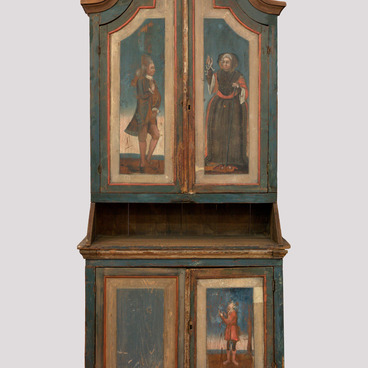The portrait of Peter I in front of the Peter and Paul Fortress from the Smolensk Museum-Reserve collection is an interesting example of provincial painting of the second half of the 18th century. Apparently, the portrait was commissioned to a local master by one of the Smolensk nobles and was placed in the ceremonial hall of a rich house. Or perhaps the portrait adorned the assembly hall of one of the Smolensk schools.
As a model for creating his canvas, the artist chose an engraving by the 18th century artist Nikita Chelnakov, which is listed as number 242 in the ‘Detailed Dictionary of Russian Engraved Portraits’. This engraving, in turn, was made from the original by Jacopo Amikoni, an Italian artist, author of numerous allegorical compositions.
Such image of Peter was very popular, and, accordingly, replicated, since it demonstrated emperor’s military victories and merits. The provincial master studiously transferred all the features of this composition to the canvas. The artist was bad at perspective drawing, and imprecisely conveyed the anatomical features of a person, so a lot in Peter’s portrait looks naive. The artist carefully wrote out all the small details, no matter how far away they are. Each element of the composition symbolizes the success and victory of the king. So, Peter leans on the cannon with his right foot, which speaks of his military victories. To the right of the emperor’s figure is the image of two drums, which also speaks of glorious military deeds. On the left is a stack of books, which refers the viewer to the legislative activity of the emperor. A ship can be seen behind the image of the Peter and Paul Fortress — evidence of the tireless labors in construction of the Russian fleet. The telescope in Peter’s indicates the same.
The color scheme of the picture is peculiar. The provincial artist had a black and white engraving as a model, so he himself chose certain colors in his painting. The color of the officer’s scarf on Peter’s belt is especially characteristic. It rather resembles silk Slutsk belts, which were worn in the Lithuanian principality to demonstrate prosperity.
As a model for creating his canvas, the artist chose an engraving by the 18th century artist Nikita Chelnakov, which is listed as number 242 in the ‘Detailed Dictionary of Russian Engraved Portraits’. This engraving, in turn, was made from the original by Jacopo Amikoni, an Italian artist, author of numerous allegorical compositions.
Such image of Peter was very popular, and, accordingly, replicated, since it demonstrated emperor’s military victories and merits. The provincial master studiously transferred all the features of this composition to the canvas. The artist was bad at perspective drawing, and imprecisely conveyed the anatomical features of a person, so a lot in Peter’s portrait looks naive. The artist carefully wrote out all the small details, no matter how far away they are. Each element of the composition symbolizes the success and victory of the king. So, Peter leans on the cannon with his right foot, which speaks of his military victories. To the right of the emperor’s figure is the image of two drums, which also speaks of glorious military deeds. On the left is a stack of books, which refers the viewer to the legislative activity of the emperor. A ship can be seen behind the image of the Peter and Paul Fortress — evidence of the tireless labors in construction of the Russian fleet. The telescope in Peter’s indicates the same.
The color scheme of the picture is peculiar. The provincial artist had a black and white engraving as a model, so he himself chose certain colors in his painting. The color of the officer’s scarf on Peter’s belt is especially characteristic. It rather resembles silk Slutsk belts, which were worn in the Lithuanian principality to demonstrate prosperity.

